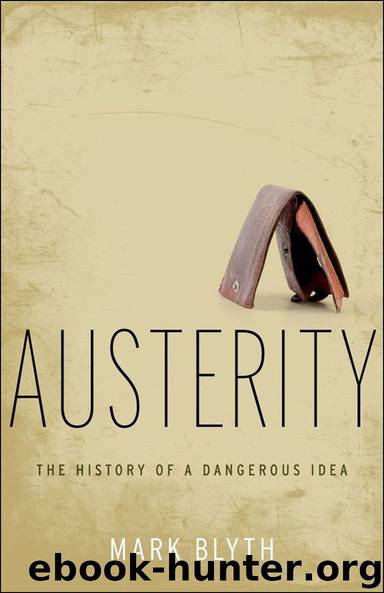Austerity: The History of a Dangerous Idea by Blyth Mark

Author:Blyth, Mark [Blyth, Mark]
Language: eng
Format: epub, azw3, mobi
Tags: The History of a Dangerous Idea
Publisher: Oxford University Press, USA
Published: 2013-03-06T23:00:00+00:00
Part Two: Austerity’s Enablers
Crowding out Keynes Globally: Monetarism, Public Choice, and the Dangers of Democracy
Despite their finding German homes and American pied-à-terres, appreciating why these decidedly local ideas were able to spring to global prominence in the current crisis requires an engagement with what I term austerity’s enablers: broader ideological and institutional shifts that bit-by-bit brought austerity back to the status of economic common sense after it had been relegated so decisively to the status of old-time religion. We encountered some of these ideas in chapter 2 when we detailed the rise of ideas about efficient markets and of investors with rational expectations—and we noted how the crisis punctured belief in these ideas. But these ideas did not sit alone in the financial markets. They were part of a much broader intellectual shift in economics and economic policy worldwide that was part and parcel of the tearing up of the Keynesian instruction sheet in the 1970s. It is the rise of these neoliberal ideas that enabled the return of austerity as the commonsense thing to do in a slump. Remove these ideas from the intellectual fossil record and it is impossible to jump from the battered and isolated state pro-austerity ideas found themselves in by the 1960s to their modern instantiations.58
Critical here were the ideas of so-called monetarist and public choice economists. What united these ideas and made them politically powerful was their joint production of the state as the inflationary pump rather than the economic shock absorber. By painting the state in this way, they made the state “doing more” a dangerous idea. In short, classical liberals produced austerity by default, Austrians and ordoliberals produced austerity by design, and latter-day neoliberals produced austerity by exclusion: by definition, any other policy would fail. Taken together, they made it possible for austerity to become, once again, last idea standing.
Download
Austerity: The History of a Dangerous Idea by Blyth Mark.azw3
Austerity: The History of a Dangerous Idea by Blyth Mark.mobi
This site does not store any files on its server. We only index and link to content provided by other sites. Please contact the content providers to delete copyright contents if any and email us, we'll remove relevant links or contents immediately.
The Secret History by Donna Tartt(18851)
The Social Justice Warrior Handbook by Lisa De Pasquale(12143)
Thirteen Reasons Why by Jay Asher(8799)
This Is How You Lose Her by Junot Diaz(6796)
Weapons of Math Destruction by Cathy O'Neil(6148)
Zero to One by Peter Thiel(5689)
Beartown by Fredrik Backman(5600)
The Myth of the Strong Leader by Archie Brown(5427)
The Fire Next Time by James Baldwin(5250)
How Democracies Die by Steven Levitsky & Daniel Ziblatt(5129)
Promise Me, Dad by Joe Biden(5088)
Stone's Rules by Roger Stone(5027)
A Higher Loyalty: Truth, Lies, and Leadership by James Comey(4846)
100 Deadly Skills by Clint Emerson(4841)
Rise and Kill First by Ronen Bergman(4705)
Secrecy World by Jake Bernstein(4651)
The David Icke Guide to the Global Conspiracy (and how to end it) by David Icke(4628)
The Farm by Tom Rob Smith(4439)
The Doomsday Machine by Daniel Ellsberg(4419)
